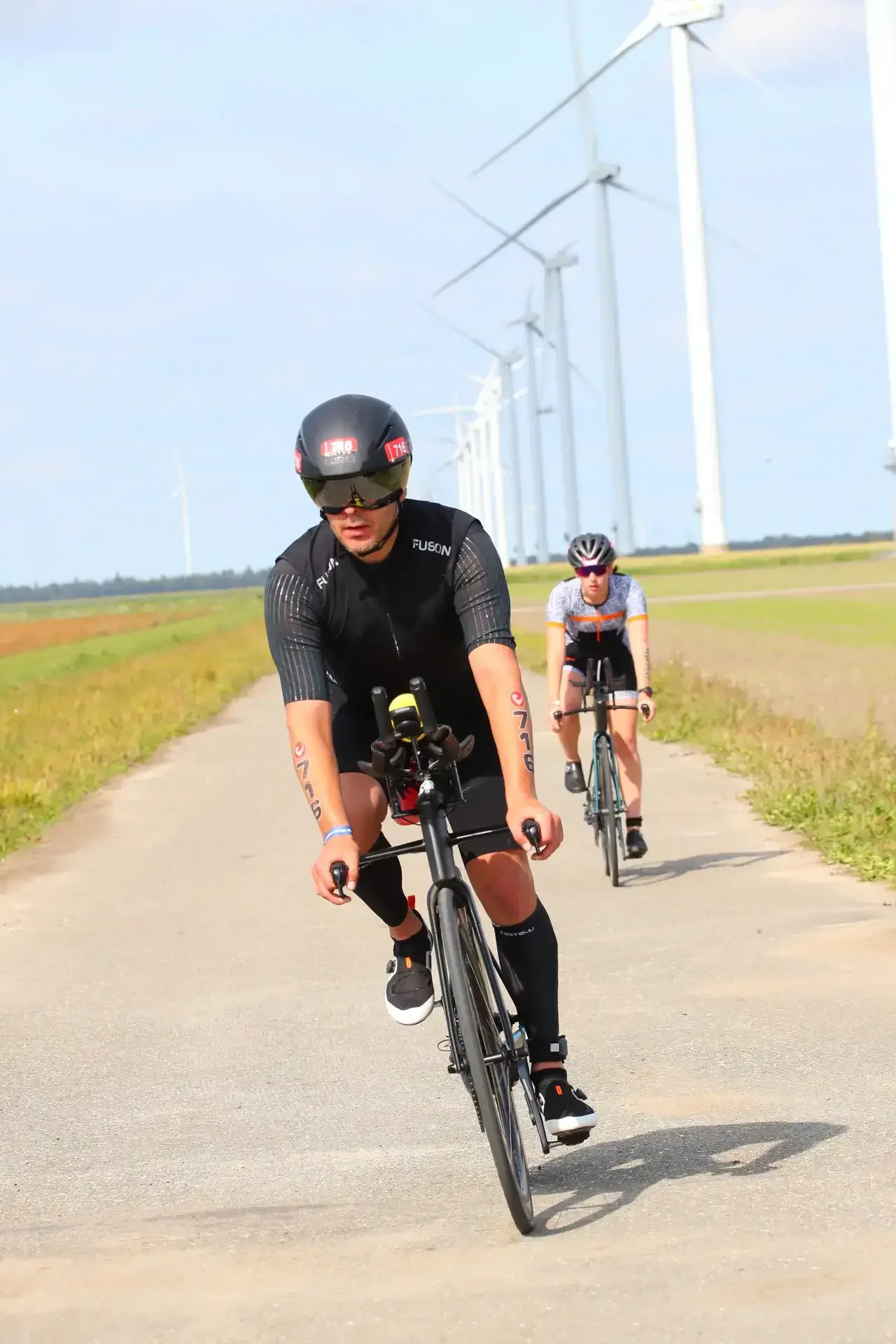Race Report: Full Distance Challenge Almere-Amsterdam
This time around, a race report by one of our athletes tackling the full distance at Challenge Almere-Amsterdam. Here’s a breakdown of how the day unfolded.
Before the Race
In the lead-up to the race, my coach and I agreed on a shorter taper. By Thursday, my legs were still feeling the season of training—stiff, sore—but by Friday, I felt good to go. This confirmed to me that we’d made the right choice. With my gear ready and race plan set days in advance, Friday was pretty uneventful, despite it being bike and bag drop-off day. Dropping the gear off was routine at this point. I stuck to my usual plan: a solid lunch, something lighter in the evening, and an early night. I knew the 4:30 AM alarm would come fast, but I got some solid sleep, which was a relief.
Saturday morning was straightforward. The last bits of prep—hydration on the bike, personal needs bag dropped—went off without any problems. After that, there was the long, usual wait between transition zone closing and the swim start. The weather held up—it was cold, sure, but at least it wasn’t raining. After freezing my way through the full distance at Klagenfürt earlier this year, I wasn’t taking any chances. I shoved a windbreaker into my bike bag because I was sure I wouldn’t regret it.
Swim
The swim brought back some memories. Mass starts feel like a thing of the past with rolling starts becoming the norm, but Almere went old-school. No complaints from me—I’ve never had a problem with packed swims. I lined up at the front by the buoy, waited for the cannon, and got to work. The cold water made it hard to settle into a flow, and navigating around athletes from earlier waves didn’t help. Some were from the European Championships group, which meant a lot of dodging and passing. Frustrating, but nothing I wasn’t ready for. I focused on staying patient and stuck to my pace, keeping in mind that this was just the start of a long day. Even with the interruptions, I came out of the water in just under an hour, which was exactly where I wanted to be. No unnecessary effort—just ticking the box.
Bike
A smooth transition, and I was out onto the bike course. The goal here was clear: keep it steady, stick to the nutrition plan, and avoid burning out too early. The first 90km loop went by without much to report. The only real issue was a wasp sting—annoying, as I had to get out of the aero position to pull it from my arm, but no big deal. The special needs bag setup wasn’t the most efficient (to understate the matter….), which added a few minutes of wasted time, but nothing critical.
The second loop was a different story. Around the 90km mark, the middle-distance athletes joined the course, and things got messy. There was a lot of overtaking and dodging going on, and it felt chaotic for the entire loop. It’s a miracle I didn’t see any crashes happen, given how tight things got out there. The entirety of the second loop turned into a passing game. Despite the disruptions, I kept on top of drinking, eating, and my pace.
Mentally, I’d prepared for a low point around the 3-hour mark—something I’ve hit in training rides—but surprisingly, it never came. The ride felt smooth, and I finished comfortably under 5 hours. Coming off the bike, I was shocked at how fresh my legs still felt. I was expecting the usual post-bike stiffness, but nothing. I went through transition without any drama and headed out for the run.
Run
For the run, I decided not to use a watch. I wanted to run by feel, knowing that trying to force a pace could backfire. I stuck to the nutrition plan I’d been training with—alternating between two cups of coke and two cups of water plus a gel at each aid station. But here’s where hindsight kicked in: for the cooler conditions we had on race day and the easy pace I was holding, this plan ended up being overkill. I wasn’t sweating much, and all that liquid started to build up in my stomach.
By the time I hit kilometre 25, my stomach had had enough. I couldn’t take in any more fluids or nutrition from that point on. This turned the last 10 kilometres especially into a real grind. Without the ability to fuel, it became more of a mental battle than a physical one. I just had to keep moving forward, knowing I was on track to finish, but it wasn’t going to be comfortable.
I focused on keeping moving, even as the energy dropped off. I knew my fitness would get me through, and that’s what I relied on. The clock didn’t matter anymore—just getting to that finish line did.
After
Crossing the line was a relief, but the aftermath wasn’t easy. My stomach was still a mess, and standing around waiting for my street clothes while listening to the person next to me list off a bunch of snacks—crisps, marshmallows, and what else—didn’t help. Definitely not what I wanted to hear in that moment.
In the end, I didn’t hit the time I was aiming for. I had been on track, but that’s long-distance racing for you. Things go wrong, and it’s about how you handle them. I’m content with how I dealt with the issues I faced. Pushing through the stomach problems and finishing strong is something I can be satisfied with. Not every race goes to plan, but I hung in there and got it done.
Now, it’s on to the next one.

